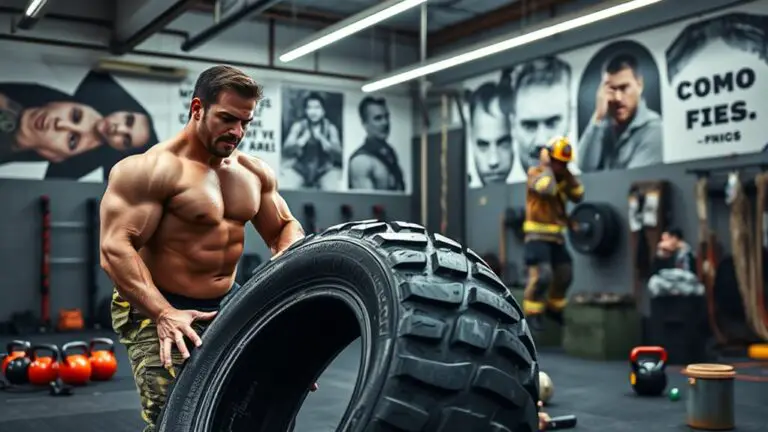The Role of Progressive Overload in Strength Training

Progressive overload is key for building strength. It means gradually increasing demands on your muscles, whether by lifting heavier weights, adding more repetitions, or increasing sets. This method activates muscle fibers and encourages growth through protein synthesis and hormonal responses. Just remember to maintain proper form to avoid injuries and adjust as needed. By understanding how to implement progressive overload effectively, you can optimize your training and reach your goals faster. There’s more to explore about maximizing your gains.
Understanding Progressive Overload

When you’re aiming to build strength, understanding progressive overload is vital. This principle involves gradually increasing the demands on your muscles to encourage strength adaptation. It’s not just about lifting heavier weights; you can also adjust the number of repetitions, sets, or even the speed of your movements.
To guarantee safety while implementing progressive overload, start with weights that feel manageable. As you get comfortable, make slight increases—about 5-10%—to avoid injury. Listen to your body; if you feel sharp pain or extreme fatigue, it’s important to back off and reassess your approach.
The Science Behind Muscle Growth
When you lift weights, your body triggers several processes that lead to muscle growth. It recruits muscle fibers, stimulates protein synthesis, and activates hormonal responses that all work together to increase strength and size. Understanding these mechanisms can help you optimize your training for better results.
Muscle Fiber Recruitment
Understanding muscle fiber recruitment is fundamental for anyone looking to optimize their strength training efforts. When you engage in resistance exercises, your body activates different fiber types—slow-twitch and fast-twitch fibers—depending on the intensity and duration of the activity. Slow-twitch fibers are more endurance-oriented, while fast-twitch fibers are essential for explosive strength. By progressively overloading your muscles, you encourage greater muscle activation, leading to enhanced performance and growth. It’s important to balance intensity to prevent injury; always prioritize proper form and listen to your body. Incorporating variety in your workouts can help guarantee you’re effectively recruiting all fiber types, maximizing your gains while staying safe. This approach sets a solid foundation for long-term strength training success.
Protein Synthesis Stimulation
To maximize muscle growth, it is essential to grasp how protein synthesis stimulation works. When you engage in strength training, your muscles experience tiny tears, which is a natural part of the process. Afterward, your body kicks into gear, repairing those tears through protein synthesis. This process not only helps rebuild muscle fibers but also makes them stronger. To support effective muscle recovery, it’s important to consume adequate protein, as it provides the building blocks needed for this synthesis. Timing matters too; consuming protein shortly after your workout can enhance this process. By understanding and facilitating protein synthesis, you can optimize your strength training results while ensuring your body stays safe and healthy.
Hormonal Response Activation
Although many factors contribute to muscle growth, hormonal responses play a vital role in how effectively your body builds and repairs muscle tissue. When you engage in strength training, your body experiences hormonal fluctuations, particularly in hormones like testosterone and growth hormone. These hormones are essential for muscle hypertrophy and strength adaptations.
Progressive overload stimulates these hormonal responses, ensuring that your muscles are challenged and stimulated to grow. It’s important to balance your workouts with adequate recovery, as overtraining can lead to negative hormonal changes, hindering progress. By focusing on safe and gradual increases in resistance, you can optimize these hormonal responses, promoting muscle growth while minimizing injury risk. Remember, strength training is as much about smart practices as it is about lifting weights.
Different Methods of Implementing Progressive Overload
There are several effective methods for implementing progressive overload in your strength training routine. First, consider a volume increase by adding more sets or reps. You can also boost intensity by lifting heavier weights, but do this gradually to guarantee safety. Frequency adjustment, like training a muscle group more often, can further enhance gains. Incorporating exercise variation keeps your workouts fresh and challenges your muscles differently. Don’t forget about technique refinement; perfecting your form can lead to better results without added strain. Load manipulation is essential, so adjust the weights responsibly. Altering rest intervals might also enhance performance, allowing for more effective workouts. Choose the right equipment to match your goals, and consider adjusting your training split to target different muscle groups effectively. Finally, modifying your rep range can help you focus on strength or hypertrophy, depending on your objectives.
Common Mistakes to Avoid

Implementing progressive overload can yield impressive results, but it’s easy to make mistakes that hinder your progress. One common pitfall is ignoring form. You might be tempted to lift heavier weights without mastering proper technique first, leading to injuries. Always prioritize maintaining good form over increasing weight.
Another mistake is failing to recognize when you’re hitting a plateau. If your workouts become stagnant, it’s essential to adjust your approach rather than pushing through without a plan. This can involve varying your exercises, rep ranges, or rest times.
You should also be cautious of form misconceptions. Some might believe that more weight is the only way to progress, but increasing volume or intensity can also be effective. Be mindful of these mistakes, and you’ll set yourself up for safer, more effective strength training. Remember, it’s about consistent, gradual improvement, not just lifting heavier weights.
Tracking Your Progress Effectively
Tracking your progress is essential for achieving your strength training goals. By setting clear objectives, using training logs, and monitoring performance metrics, you can see how far you’ve come and what needs improvement. Let’s explore how these strategies can enhance your training experience.
Set Clear Goals
Setting clear goals is essential for effective progress tracking in strength training. By focusing on goal setting, you can define specific outcomes that help you stay motivated and safe. Here are four tips to guide you:
- Define Your Objectives: Determine if you want to increase strength, endurance, or muscle mass.
- Make Them Specific: Set measurable targets, like lifting a certain weight or completing a set number of reps.
- Set a Timeline: Establish a realistic timeframe for achieving your goals, ensuring you’re not pushing too hard too quickly.
- Reassess Regularly: Periodically evaluate your goals and adjust them based on your progress and safety concerns.
Use Training Logs
While many lifters focus on their workouts, keeping a training log can be just as essential for your strength training journey. It helps track your progress, ensuring training consistency and facilitating workout variations. By recording your lifts, sets, and reps, you can identify patterns and make informed adjustments to your routine. This practice not only boosts motivation but also enhances safety, as you’re more aware of your limits.
| Date | Exercise | Weight/Volume |
|---|---|---|
| 2023-10-01 | Squats | 3×10 @ 150 lbs |
| 2023-10-01 | Deadlifts | 3×8 @ 200 lbs |
| 2023-10-02 | Bench Press | 3×10 @ 120 lbs |
Start logging today, and you’ll see how it transforms your training experience!
Monitor Performance Metrics
To maximize your strength gains, it’s essential to monitor performance metrics regularly. Keeping track of your progress not only helps you stay motivated but also guarantees you’re training safely. Here are some key performance indicators to reflect on:
- Weight lifted: Track the amount of weight you can lift for each exercise.
- Repetitions and sets: Note the number of reps and sets completed to gauge endurance.
- Rest periods: Monitor your rest times to maintain workout intensity.
- Workout feedback: Take notes on how you feel during and after workouts to identify patterns.
Tailoring Progressive Overload to Your Goals
Tailoring progressive overload to your specific fitness goals is essential for achieving ideal results. Whether you’re aiming for muscle gain, endurance, or weight loss, using goal-specific strategies will help you progress safely. Personalized training plans consider your current fitness level and goals, allowing you to adjust your workouts effectively.
Here’s a quick reference table to help you choose the right approach to progressive overload based on your objectives:
| Goal | Strategy | Example |
|---|---|---|
| Muscle Gain | Increase weight gradually | Add 5% more weight weekly |
| Endurance | Increase reps or duration | Add 1-2 reps each session |
| Weight Loss | Circuit training with reduced rest | Shorten rest by 10 seconds |
The Importance of Recovery in Strength Training

Progressive overload is only part of the equation for strength training success; recovery plays a vital role in your overall performance and progress. Proper recovery helps prevent injuries, enhances your results, and supports mental recovery. Here are some key aspects to reflect on:
- Sleep Quality: Aim for 7-9 hours of restful sleep to promote muscle repair and recovery.
- Nutrition Balance: Fuel your body with a mix of proteins, carbs, and healthy fats to support recovery.
- Hydration Importance: Staying well-hydrated aids in recovery and helps maintain peak performance.
- Active Recovery: Incorporate foam rolling and stretching techniques to alleviate soreness and improve flexibility.
Frequently Asked Questions
How Often Should I Increase My Weights for Progressive Overload?
You might think you should always lift heavier weights, but it’s important to listen to your body. Generally, you can increase your weights every 2–4 weeks, depending on your training frequency and how you’re feeling. Opt for small weight increments, like 2.5 to 5 pounds, to guarantee safety and proper form. This gradual approach helps prevent injury while still promoting strength gains, allowing you to progress effectively and enjoyably.
Can Beginners Use Progressive Overload Effectively?
Absolutely, beginners can use progressive overload effectively! It’s essential to maintain a beginner mindset and focus on training consistency. Start with manageable weights, ensuring you’re comfortable with your form to avoid injury. Gradually increase the challenge by adding weight or reps as you grow stronger. Remember, it’s about progress over perfection—listen to your body and take your time. This way, you’ll build a solid foundation for long-term success in your training journey.
Is It Necessary to Change Exercises for Progressive Overload?
You don’t necessarily have to change exercises for progressive overload, but it can be beneficial. By incorporating exercise variation, you can target different muscle groups and prevent plateaus. However, if you prefer to stick with your current exercises, intensity adjustments, like increasing weight or reps, can also promote progress. Just make sure you’re prioritizing safety and maintaining proper form to avoid injury as you increase the challenge of your workouts.
What Role Does Nutrition Play in Progressive Overload?
Nutrition plays an essential role in your progress. To maximize your results, focus on nutrient timing and guarantee you’re getting enough protein intake. Consuming protein after workouts helps repair muscles and supports growth, making your efforts more effective. It’s important to maintain a balanced diet to fuel your body adequately, so you can safely increase your strength over time. Remember, your nutrition is just as important as your training routine!
Can I Apply Progressive Overload to Bodyweight Exercises?
Absolutely, you can apply progressive overload to bodyweight exercises! Some might think bodyweight workouts lack intensity, but there are plenty of bodyweight variations that can challenge you. By adjusting the angle or adding pauses, you can create resistance adaptations in your muscles. Just guarantee you maintain proper form to stay safe. So, whether it’s elevating your feet during push-ups or increasing reps, you can effectively progress your strength with bodyweight exercises.





